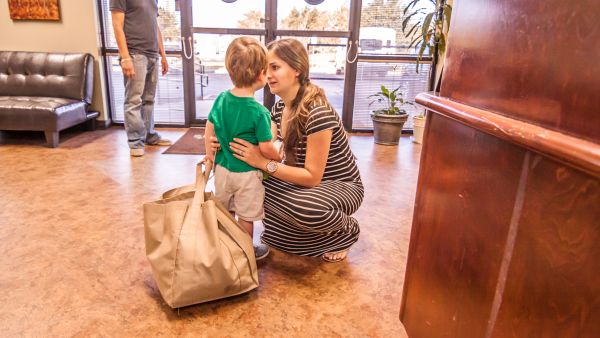
Whether it’s the first day at daycare or the first day at school, a little crying is expected. Every child experiences some sort of separation anxiety in the early years. In actuality, separation anxiety can start as early as nine months, when babies begin to understand that they aren’t physically connected to their source of food and comfort. Of course, by the time they reach preschool age, children realize that though mommy or daddy don’t disappear forever when they’re gone from sight, children still know they’re being left “alone.”
Check out these six ways you can ease the transition.
Familiarity Breeds Comfort
Children (and adults!) naturally feel more comfortable when they are in a familiar place. Separation anxiety can have a lot of root causes, but one may involve the physical building itself. You child may be worried about having a bathroom accident because she doesn’t know where the toilet is. She may worry she’ll get lost in that big building, or forget which classroom is hers. Anything you can do in the days and weeks before the actual separation to make the place more familiar will reduce at least some of their anxiety.
Consider:
- Visiting the classroom or daycare setting several times before the first day
- Making arrangements to meet the teacher or caregivers ahead of time
- Assuring your child that she can bring a “lovey” or some other comfort item to the classroom
Find Their Friends
The teacher or caregiver is only one of the new people your child will be meeting on the first day of school. If your daughter or son is particularly shy or reserved, separation anxiety may also involve some social anxiety. She will wonder: Will they like me? Will I like them? Will they be mean?
If possible, try to arrange a casual, outdoor play date with one, two, or several of the children in the school in the weeks before the session begins. Even if your child hangs back from shyness, at least he or she will recognize many of the faces when he finally walks into the classroom setting.
Set Up Rituals
Setting up a ritual is a great way to instill a good habit, especially for children who struggle when facing a difficult or anxiety-producing transition. For example, developing a familiar bedtime ritual—bath, book, and bed—is a great way to settle children who seem to get a second wind around 9 pm. Similarly, practicing the morning routine of a new school day is a great way to lessen anxiety.
Setting up a ritual may involve:
- Choosing lunch foods the night before
- Setting up the backpack the night before
- Placing shoes, coat, and stuffed backpack by the front door
- Laying out school clothes the night before
- Waking up at a specific hour to start the day
Be Brisk, Loving, No-Nonsense
Let’s face it, a child’s first day of school or day care is tough on you, too. In the face of your child’s tears you’ll likely be full of guilt and indecision. Yet both teachers and many child psychologists suggest that the best way to separate is to hug them, kiss them, tell them that you love them and will see them later. Then make a brisk and no-nonsense exit—and don’t come back. Once you’re out of sight, then you can let the tears fall.
This won’t prevent your children from crying, of course. Teachers and caregivers will tell you that most children are easily distracted once you are gone, and soon settle into the routine.
Be True To Your Word
Keeping your promises is critical. If you tell your child that you’ll be back to pick them up after nap time, make sure—especially in those first few critical weeks—that you commit to that time table. If a child’s expectations are thwarted then they will feel as if their anxiety is justified. It will take all the longer to make him trust your word again.
Let Your Joy Show!
As difficult as drop-off may be, don’t lose the chance to celebrate the pick-up time! By showing your joy you’re telling your child how glad you are to see him or her again. Listen to their stories, peruse their artwork, and, if they aren’t already doing it, encourage them to tell you about their day. In the best of situations, your child will still remember the happy returns when they face the morning good-bye all over again.





















